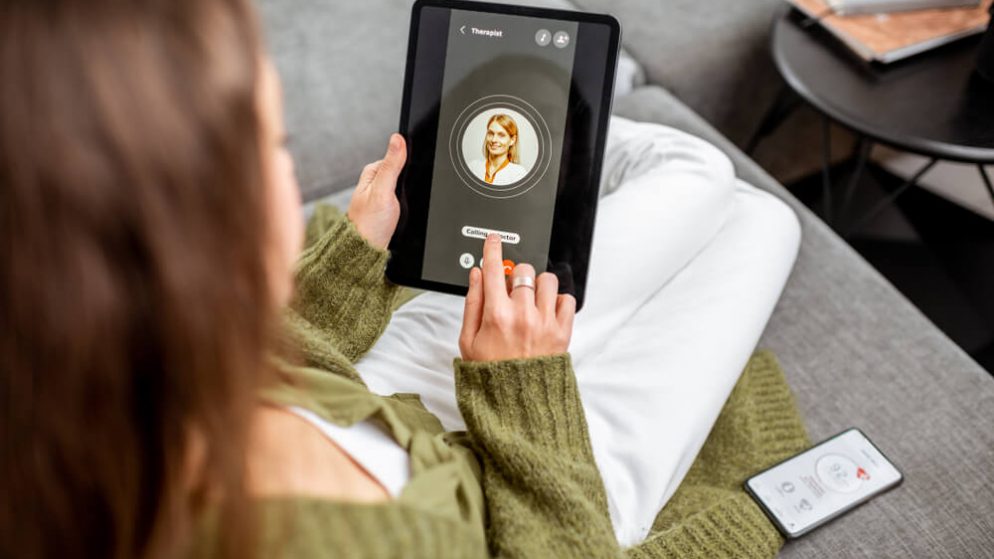



Get new exclusive access to healthcare business reports & breaking news




Telemedicine has become an accessible, efficient, affordable healthcare solution for patients throughout the pandemic. When the government mandated a shutdown, the use of telehealth experienced a rapid increase in mental and physical health issues.
The pandemic took a toll — including on the nation’s mental health. According to the World Health Organization, the COVID-19 pandemic increased anxiety and depression by 25% globally due to many factors. Social isolation, fear of being infected, financial stress and many other stressors lead to mental health disorders and suicidal behaviors.
With many unable to access face-to-face care, telemedicine became the outright solution to closing the gap in healthcare. Even though the pandemic is still ongoing, what will happen to telehealth once COVID-19 recedes?
COVID-19 has proven that telehealth brings numerous benefits to healthcare nationwide.
In fact, telehealth has risen in popularity so much that 85% of doctors are currently using it. However, federal and state regulations could be the downfall of this excellent solution.
Here is an overview of what those regulatory changes look like today.
The federal and state governments classify their regulatory changes into four primary categories, including the following.
Changing HIPAA policies allows healthcare providers to use video calling technology even if it doesn’t meet privacy rules. Following these changes, patients and physicians can connect via telehealth applications like FaceTime and Facebook Messenger.
The Centers for Medicare & Medicaid Services permitted several changes that affect reimbursement directly, including:
Many states allowed temporary licenses to allow physicians to practice in other states and increase access to telehealth.
Doctors are allowed to prescribe controlled substances regardless of location via telehealth visits.
If each policy change remained the same, telehealth would move past the barriers and transform how physicians deliver nationwide.
Telehealth has made an immeasurable impact on healthcare delivery.
HIPAA flexibility has allowed FaceTime between doctors and patients in different states. The 24/7 virtual visits have given patients access to affordable care.
With some national vendors, patient care telehealth visits can start as low as $50 — a noticeable reduction from in-person appointments.
Another significant benefit of telehealth is it can allow hospitals to provide improved care. Researchers in an Australian study found the service could reduce costs in the long term, but there is not currently evidence it will save them money. However, they emphasize how much treatment could improve with remote services.
More physicians are embracing telehealth because of this advantage — the market size may grow to $130 billion by 2025.
However, local providers have had a natural advantage over the national vendors. They’ve established relationships with their patients, which justifies the higher costs for healthcare services.
Yet it’s unlikely in the long run that patients will tolerate the prices of face-to-face visits in the future. Therefore, local providers would have to determine how to streamline the overhead costs and workflow to create sustainable telehealth if governments retract their relaxed regulations.
While telehealth has provided many conveniences for patients without access to primary care providers, one report shows consumers prefer virtual care over in-person visits.
According to Fierce Healthcare, Amwell’s telehealth visits increased by 16% in the first quarter of 2022 compared to 11% in the last quarter of 2021. Though some reports show a drop in Telehealth visits in March, teletherapy has remained robust among mental health patients.
Even urgent care visits for common diagnoses jumped in popularity within the last year.
Further statistics show that telehealth plays a more prominent role in mental health and substance use care. In contrast, outpatient care via telehealth has decreased.
According to KFF and Epic Research, Telehealth received 40% of mental health and substance use outpatient visits in 2020. At the same time, other outpatient visits represented 11% of telehealthcare.
In context, the data suggests an alarming increase in patients reporting depression and anxiety symptoms and substance use. Given these concerns, mental health and substance use care will need to be accessible more than ever through telehealth.
Many have expressed concern over telehealth services going away once the crisis eases. Therefore, the question remains — what will happen to telehealth once COVID-19 subsides?
Patients and healthcare providers worry they’ll lose access to virtual care. Many patients can connect to their providers without having to travel. Statistics even show that 95% of healthcare providers offer remote treatment.
For many, telehealth is most convenient when they live in remote areas or are hours away from their healthcare provider.
However, patients across the U.S. worry a change in rules will force remote visits to end. Many states are terminating emergency regulations, including remote care across state lines. Additionally, federal agencies that have relaxed HIPAA regulations may reverse the flexible policy after the pandemic.
Making access to telehealth more difficult makes it more challenging for patients to get the quality care they need. For example, some patients have to visit other states to make their telehealth visits fall within regulations.
Some doctors even consider the risk of practicing without a license or payment — or dropping their patients.
Before states relaxed the licensing rules, doctors had to pay hefty fees and fill out lengthy paperwork to get a license across every state.
Now that states are retightening the licensing rules, many doctors worry about their patients’ making long, potentially dangerous trips to attend in-person visits.
A person with heart failure needs frequent monitoring. However, patients like this can do this safely from home. But receiving care from home may be no longer available. Even if physicians were to get their medical licenses in other states, it’s still not a simple matter.
In some states, acquiring a license is exceptionally tedious, expensive and time-consuming.
However, leaders are looking for licensing solutions that could allow interstate agreements. The IMLC or Interstate Medical Licensure Compact offers one path to licensing in over 30 states. This process still takes time and requires another step, such as fingerprinting.
Other options require the federal government to devise a solution. Therefore, this leaves some advocates hopeful for federal legislation to take congressional action in enabling nationwide care.
Before regulations for Medicare changed, telemedicine was for rural patients only. But once federal rules changed, they allowed any Medicare patient to use telehealth.
Medicare insures millions of older and disabled Americans and its actions can influence what the state agencies and private insurers determine.
Aside from that, one question remains — how long will the government extend emergency regulations? For now, they set it to expire in January but can still renew it.
The long-term solution to Medicare’s telehealth coverage would be a permanent extension. Yet, that would require congressional approval. If Congress doesn’t pass the public health emergency, Medicare will return to excluding in-home virtual visits and coverage anywhere — aside from rural areas.
In addition to covering the geographic issues, Medicare added dozens of new services, including eye exams and speech therapy. The agency is now weighing on which of those services to renew, but it’s unclear which services they will cover.
Another part that isn’t entirely straightforward is the intentions of other telehealth providers. Many states require private insurers to cover remote visits. If they continue to issue this requirement, one variable in question is whether payers will be encouraged — or would they choose — to reimburse telemedicine.
As of now, less than half the states are mandating this requirement. Meanwhile, other providers are working to assist patients in understanding the possible changes.
With the HIPAA privacy standards being flexible, many providers pivoted to FaceTime, Zoom and other user-friendly platforms. Yet as hospitals return to HIPAA-compliant tools, patients are urging more improvements of these tools with easier-to-use features.
Many people are digital illiterate or low in literacy and telemedicine marginalizes these patients. For example, some patients only know how to use audio-only calls because videoconferencing is too difficult for them to set up.
With Medicare and many states recognizing this reality, governments permitted audio-only visits during the pandemic. However, that will change for many people.
For instance, after the public health emergency, Medicare plans to cover audio-only visits exclusively for patients needing mental health services. Meanwhile, some doctors worry that the loss of audio visits is possible.
Since some geriatric patients cannot use video, loss of audio-only coverage for them would only hinder their visits — especially for those with transportation challenges.
Of course, even with audio-only coverage, many patients lack broadband access. Therefore, telemedicine visits necessitate internet availability, only furthering the need for government funding to bolster access.
The latest federal and state policy changes have resulted in increased adoption of telemedicine by family providers and their patients. Sustaining these changes — or at least the majority — would encourage physicians to make more organizational investments in telehealth.
As a result, this would increase access to healthcare services for all patients and potentially improve its equity. It’s a matter of making people’s voices heard on the issue and informing state legislators about licensure and Medicaid issues.